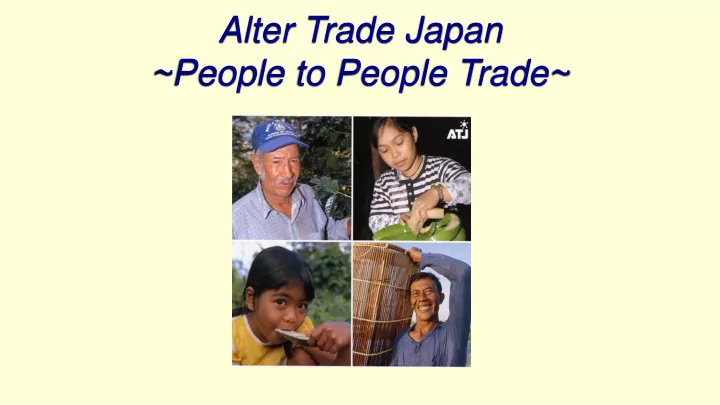

Alter Trade Japan ~People to People Trade~
People to People trade is more people’s relationship -centered and based on “SANCHOKU - System”. The core principal is “Self - Reliance” and “Mutual Benefit” for the stakeholders, based on the common concept of Fair trade, .
Alter Trade Japan • Alter Trade Japan (ATJ) established in 1989; – as incorporation with nature of cooperative, social business entity (SCBE) by multiple stakeholders such as consumers’ cooperative, social business entity, civil groups and individuals, – for solving food and livelihood problem for both producers and consumers with sustainable production through People to People Trade (P to P).
Background of People to People Trade • The origin of People to People trade was from the disastrous historic event in mid- 1980’s in Negros, the Philippines that many people engaged in sugar labor and industries faced sudden crisis in life due to the crash of international market sugar price. • Civil groups and church related groups started to emergency activities to help people under life- threating condition such as no-income and starvation. • Later, the activities faced matters of financial source and people’s dependency, then shifted to more sustainable way to change situation.
Objective of P to P • People to People Trade aims to achieve social mission through trading. • For those producers who has been produce mono-crop, P to P partners encourage them to be empowered to multi variety production, and be capable of livestock mixed production through training and stable income generation based on the basic production as next level of development.
Partners of People to People Trade • People to People Trade Partner, in the Philippines, Indonesia,. East Timor, Laos and Palestine, work with small-scale producers. • The producers belong to community group and producers organizations in the community, but organizations are not necessarily in the form of cooperatives. • As long as the group functioned for the members benefit through the cooperative manner, the groups can be the member of People to People trade.
Partners of People to People Trade
Development of P to P Products • In the 3 decades, 7 People to People trade products are produced and developed. • There are 3 types in categories; (1) Icon products for supporting producers (Mascobado Sugar), (2) Products developed through consumer awareness change (Balangon Banana, Ecoshrimp), (3) Products for supporting produces to solve social problem(Organic and fair trade coffees, salt by traditional production method, olive oil by the Palestine producers, Cacao by the indigenous of Papua region in Indonesia).
Development of P to P Products
As of 2018 , ATJ has been selling 7 products from 12 countries, with 14 partners’ groups. 2,000,000 Sales total in 2018 is 1.75 Billion Yen 1,800,000 (USD16.4 Million). 1,600,000 others 1,400,000 1. Mascobado Sugar (Philippines) Tea 2. Balangon Banana (Philippines) Pasta 1,200,000 Cacao 3. Ecoshrimp (Indonesia) Palestine Oliveoil 1,000,000 4. Coffee Guerande Salt East Timor Mascobado Sugar 800,000 Laos Coffees Peru Ecoshrimp 600,000 Balangon Banana Mexico 400,000 Guatemala Tanzania 200,000 Rwanda Ecuador 0 2011 2012 2013 2014 2015 2016 2017 2018 5. Palestine Olive Oil (Palestine) 6. Guerande Salt (France) 7. Cacao (Papua, Indonesia)
Role and Goal of P to P People to People trade partners….. play important roles to facilitate people and activities by providing training and support through purchasing their products stably cooperate with producers for improving livelihood through stable work and income, solving local issues by linking multiple local, regional and national stakeholders,
Critical Key factors of P to P for 30 years • Consumers’ cooperatives has engaging as Founders, Joint Business Partner as well as buyer/customer. • For sustainable circular economy, “Consumer’s Commitment and Involvement” has been the key factors. • Policy Consultation has been held regularly with consumers’ cooperatives and reached to outcome such as mission and target to be achieved.
Critical Key factors of P to P for 30 years • With consumers cooperatives, various activities have been taking; SALES PROMOTION with producers’ and production information, SEMINARS and WORKSHOP for consumers member on “food and consumption and environment”, EXCHANGE and VISIT PROGRAM between Producers and Consumers for deeper understanding about producers challenge in Production and consumers expectation, SHARING KOWLDGE and EXPERIENCE and TECHNOLOGY TRANSFER by the private sectors.
Exchange and Visit between Producers and Consumers
Promotions, Campaign
Seminars & Workshops
Creation of APF • Under the P2P Trade scheme, new challenge also has started. Asian People's Fund for Mutual Benefit was established in 2009 for supporting conscious entrepreneurs, community business and promoting P2P Trade. • The source of APF is by accumulating fund from the sales of P2P Products or Contribution by the consumers’ cooperatives in Japan and Korea currently. The fund is exclusively available for the APF member.
Principle of APF • Some organizations need to start new business while some lack experience of business • Not only financing, but also human resources, technology, experience, resources should be exchanged and supplied for those organizations. • ” Linkage system ” of technology and experience should be created for the purpose of sharing and mutual corporation among members’ organizations.
Indonesia East Timor Palestine Papua Asian Nepal Social Business Linkage Capital Pakistan Resource Technology People Philippines APF Korea Japan Loan
Challenge and Next Step • The Challenge of P2P is still diverse. Environment surrounding producers and consumer has been changing rapidly and drastically. • Each organization has unique capability, but has limited capacity, so that working together by the different organizations can widen the range of the issues to be tackled by utilizing different source and experience by sharing same mission and value for the better society.
Thank you!
Recommend
More recommend